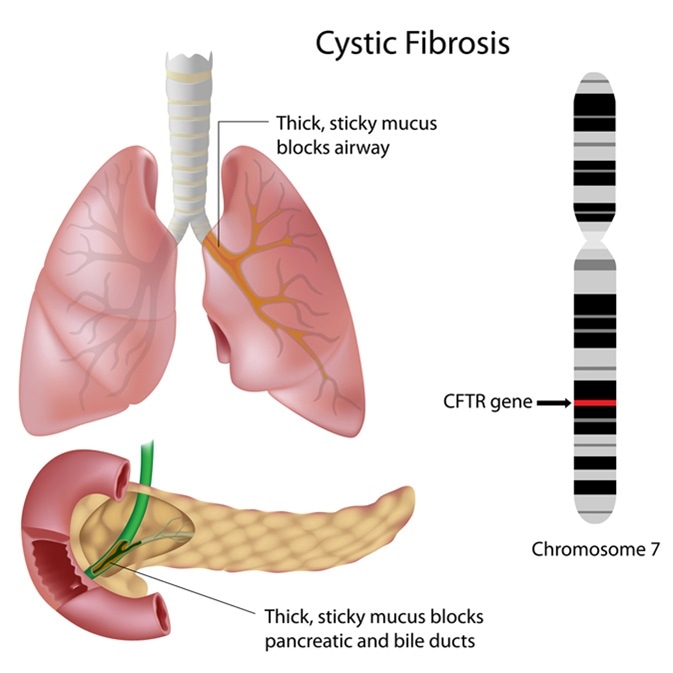Cystic fibrosis is an autosomal recessive inherited disorder affecting salt transport in and out of cells. The resulting imbalance of fluids and salts causes the production of a thick, sticky mucus and other abnormalities throughout the body. The lungs are the principal organ affected, but cystic fibrosis also affects the pancreas, gastrointestinal system, reproductive system, and many other organs of the body.
Prevalence
Cystic fibrosis affects more than 30,000 people in the U.S. and is one of the most common genetic diseases of Caucasian people. About a thousand new cases are diagnosed annually--typically within one year of birth. Lifespans have increased over the past few decades, and currently the average survival is about 40 years.

Cystic fibrosis. Image Credit: Alila Medical Media / Shutterstock
Genetics
Cystic fibrosis is caused by any of a range of mutations of the cystic fibrosis transmembrane conductance regulator (CFTR) protein. A child inherits one CFTR allele from each parent. Disease is present when both alleles have mutations. A person who has a mutation on just one allele is a carrier. More than 70 percent of cases of cystic fibrosis are caused by the f508del mutation, but over a thousand other mutations have been identified.
Different Populations
The prevalence of cystic fibrosis varies quite a bit between different racial and ethnic groups. The birth prevalence among those Caucasian people in the U.S. who have North European heritage is 1:2500. This is 13 times higher than Asian-American populations, where the prevalence is 1:32 000.
Worldwide, the incidence of cystic fibrosis is as high as 1:377 in parts of England and as low as 1:90 000 among Asian people in Hawaii. In Europe, the rate of cystic fibrosis is between 1:2000 and 1:3000 births. In southern Africa, the carrier frequency is 1 in 42, with a calculated incidence of 1 in 7056 births. The incidence in Latin America ranges from 1:3900 to 1:8500. Estimates for the Middle East are between 1:2560 and 1:15,876.
Cystic fibrosis is rare among Asians. In India, the prevalence is estimated at around 1:40 000 to 1:100 000 births. In Japan, the estimated incidence is 1:100 000 to 1:350 000.
Under-Diagnosis of Cystic Fibrosis
In some parts of the world, cystic fibrosis is under-diagnosed, and the true prevalence of the disease is not known. This includes Latin America, Africa, and India. Lack of knowledge about the disease, poor access to health care, confounding diagnoses, a high level of infant mortality in general, and low life expectancy all contribute to the under-diagnosis of the disease.
Increased Adult Population
Outcomes and survival rates for cystic fibrosis have improved drastically over the past fifty years. Once an exclusively pediatric illness due to early mortality, cystic fibrosis victims are now surviving more and more commonly into adult life. The median age of patients with cystic fibrosis in the U.S. is 17.9 years, and some patients are as old as 85 years. The proportion of adult patients has increased from 29.2 percent in 1986 to 49.7 percent in 2013.
References
- Arch Intern Med, Genetic testing for cystic fibrosis. National Institutes of Health Consensus Development Conference Statement on genetic testing for cystic fibrosis, https://www.ncbi.nlm.nih.gov/pubmed/10421275
- The Molecular Genetic Epidemiology of Cystic Fibrosis, https://www.who.int/
- Clin Chest Med., Epidemiology of Cystic Fibrosis, https://www.ncbi.nlm.nih.gov/pubmed/26857763
- Clin Chest Med., Cystic fibrosis: a review of epidemiology and pathobiology, https://www.ncbi.nlm.nih.gov/pubmed/17467547
- CFTR Science, Epidemiology: The mutational diversity of cystic fibrosis, https://www.cftrscience.ca/
Further Reading